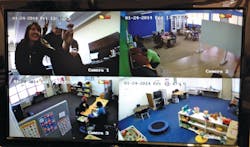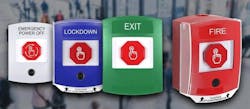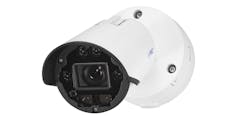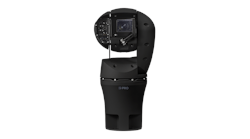Video Surveillance Solutions For Special Needs School
Video surveillance systems are an excellent product group for the locksmith to offer clients. Video cameras greatly enhance access control by allowing live monitoring of the opening from a remote location, logging (recording) of activity through the door, and, with motion detection, alarm notification when the door is opened or forced.
Cameras can indemnify a client against nuisance slip and fall claims. Cameras can be located to observe parking areas to assure employees that the area is free of predators before they leave the safety of their premises. In retail, cameras can document shoplifting and customer behaviors. As a matter of fact it has long been known that cameras deter inappropriate behavior, and encourage good behavior.
In health care and education, the value of video surveillance cannot be overstated, permitting a centralized overview of situations in classrooms and the campus, as well as recordings of classroom activities, andoff sight viewing of activities.
As is the case with every other area of security, the technology is transitioning to IP (Internet Protocol) and digital. The infrastructure for IP is wireless and Ethernet using UTP topology (wire).
Closed Circuit Television (CCTV) systems used coaxial cable for decades, but is rapidly switching over to UTP for both analog cameras as well as digital (IP) cameras. The switchover to IP and UTP can be intimidating. Ads for cameras and equipment underscore the message of how easy it is, which to the consumer is “GeekSpeak” for how hard it actually is.
The video industry has made a focused attempt (joke) to ease the transition with regards to one aspect of digital video which is one of my personal favorites, the IP configuration. Wizards (software programs) and tech support technicians help greatly in this regard. Practice will make the process go smoothly, but let’s face it, some things will never actually be ‘fun’.
Another problematic aspect of network cabling is the application of RJ-45 connectors. Sometimes cabling is provided with the connectors on the ends already, but typically you will have to install them, and it can be a real challenge.
At this point in time, the industry’s most popular network standard is CAT 5e. But that is transitional as the industry strives to satisfy our need for speed.
It is important to mention that hard-wired network speeds and capacities greatly exceed wireless and mobile formats, but we are willing to sacrifice speed and content for convenience.
Category 5 Cable (Cat5) consists of four twisted pair cables for carrying data. It is also used to carry other signals such as telephony and video. The cable is commonly connected using punch down blocks and modular connectors. Category 5 (Cat5) has been superseded by the Category 5e (Cat5e) specification (these categories are handed down by the American National Standards Institute or “ANSI”). Cat5e will support Ethernet, Fast Ethernet, and Gigabit Ethernet (10/1000). “e” is completely backwards compatible.
Cat5e is normally what is used in most applications as of 2011. Cat5e is superior to regular cat5 by less cross talk (electrical interference), a thicker PVC or PE protective jacket, and increased bandwidth (the amount of information it can carry). The differences are significant and even an un-technical user would notice a difference in performance. It’s hard to go wrong with cat5e network cable.
Shielded (STP) vs. Unshielded (UTP): Unshielded Twisted Pairs (UTP) is the most common cable used in computer networking. Most premanufactured Ethernet cables are likely to be UTP cat5e patch cable (“patch” means it’s used to connect one device to another and has the plastic caps on the end all ready to go). Shielded Twisted Pairs (STP) means the cable is constructed in such a way that it prevents electromagnetic interference. The STP cable will have a grounding wire or “drain” wire inside so the metal shielding foil will work.
Bandwidth: Cat5e network cable must meet or exceed the ANSI standard of 100 MHz with regard to bandwidth (or the size of the “pipe” in which information can flow). It is common for pure copper cat5e to go up to 350 MHz. For most applications, the user will not see much difference in day-to-day usage whether their cable is rated exactly at 100 MHz or 350 MHz.
Solid vs Stranded: Cat5e cable can be described as either SOLID or STRANDED. This term refers to how the conductor is constructed. A patch cable is likely a stranded cable. Stranded cable is generally regarded as more flexible, since the conductor is “stranded” together in smaller pieces.
Solid cat5e conductors are typically used for permanently installed longer runs such as running from room to room, etc.
Although the use of solid wire is typically discouraged in alarm and other low voltage applications, solid CAT-5 cable offers more speed, and if used as permanently installed infrastructure and it will not be moved or handled it is preferred.
The outer protective covering that you see is called the cable “JACKET”. It is commonly made out of PVC (Polyvinyl Chloride) or PE (Polyethylene) material. For most common in-wall applications PVC is the most traditional, but PE is about the same cost yet can offer a little better protection against temperature extremes and durability.
Underwriter Laboratories (UL) provides some uniformity in the classes of jacket types.
Typical in-wall rating is referred to a CM or CMG class (Communications General).
Low smoke insulation PVC jackets that are rated for RISER use are called CMR.
A higher class of smoke and flame resistant PVC jacket is rated PLENUM and is classified as CMP.
Another common rating is applied to ULTRAVIOLET coating in the jacket called CMX. This is for outdoor applications.
The application of the RJ-45 connectors can be a challenge. I’ve set out to terminate a few network cables equipped with a bag of connectors, and actually ran out of connectors before I successfully completed all my work. This amounts to a huge waste of money and time.
The conductors connectors and tiny and the color tracers on the wires are faint. If you are working under less than ideal conditions or you do not have a steady hand and a lot of experience, you may be in for a frustrating and non-productive experience.
We usually turn to Windy City Wire when we need cable. We like the quality of the wire. In addition, they typically ship from stock, and their customer support is great. Customer support helps you select the correct wire, and makes sure the product is properly labeled and routed. Last year I needed to submit a system design to a building department in order to obtain a permit and Windy City provided the product data sheets I required.
Platinum Tools makes a full line of installation tools for network and telecom (Telephone communications) installation. My personal favorite is their EZ-RJPRO® HD Crimp Tool and EZ-RJ45® CAT 5/5e Connectors which make the installation process far easier and faster than using conventional connectors and tools.
The EZ-RJPRO® HD Crimp Tool is designed for the professional installer providing a ratcheted, high leverage, ultra stable platform for consistent, repeatable terminations. This heavy duty tool is ideal when working with high performance, larger OD cables that are tougher to terminate due to larger wire gauges, thicker, harder insulation on the conductors and pair separating splines and assures that every termination will meet FCC specifications.
The patented EZ-RJ45® Connector simplifies twisted pair terminations by allowing the wires to be inserted through the connector and out the front. This allows the technician to easily verify the proper wiring order. Electrical performance of the termination is optimized by pulling the connector down over the cable jacket and seating it tightly in the rear of the connector. Reducing the distance between the wire twists and contacts improves installer performance and network performance.
I always use a cable tester before connecting equipment to the new cable.
Swann HD Security System: If you are looking to get into IP video, The Swann HD Security system would be a good system with which to cut your teeth (and not cut your throat). The system comes with prefabricated network (Ethernet) cables, cameras and the NVR (Network Video Recorder. A NVR is like a DVR (Digital Video Recorder, only its inputs are network jacks rather than coaxial BNC).
The cameras have modular connectors for the network cables. Power for the cameras is provided over the CAT 5e cables. This is referred to as Power over Ethernet (PoE).
If the cameras are located further than the provided cables permit (about 60 feet), the installer can fabricate his own cables. The system will support cables lengths up to 300 feet without having to use Ethernet extenders. One of our cameras required that we fabricate a 150-foot cable.
The cameras mount exactly as the way other video cameras do. They have a wide angle view, and produce excellent images on VGA monitor. A better image is produced if a HD monitor is used. Integral IR LEDS (Infrared Light emitting Diodes) enable the camera to produce images in total darkness.
Programming and configuration is Wizard driven; the product manual is clearly written and comprehensive; and Internet and 24/7 telephone tech support are available if you get bogged down.
The installation went as smoothly as any I’ve done, (and I have done many); and the image quality and user interface were exceptional and satisfying to all.
Our components included the Professional HD Security System, NVR4-7200™ 4-Channel 1080p Network Video Recorder and four-piece 1080p NHD-820™ cameras.
Swann’s latest network video recording security system with 1080P high definition live viewing & playback in real-time (25/30 fps per channel) State-of-the-art digital imaging technology provides 5x the picture sharpness of traditional security systems including analog D1 (and 20x the picture sharpness of traditional CIF security systems).
Full HDTV provides 1080 lines with progressive scanning (sometimes referred to as 1080p). In these specifications, the numeral indicates the number of horizontal lines in the complete raster, the p stands for progressive scanning (where each scan displays every line in the image raster sequentially from top to bottom), and the i stands for interlaced scanning (where each scan displays alternate lines in the image raster, and two complete scans are therefore required to display the entire image).
Progressive scanning is considered superior to interlaced scanning for full-motion video displays, because there is less jitter, particularly for the portrayal of objects that move diagonally or vertically across the screen. The improvement is especially noticeable for fast-moving images, typical of television and DVD programs. Another advantage of progressive scanning is the fact that it is required for satisfactory video on TV sets that use micro displays, plasma displays, or liquid-crystal display (LCD) flat panels, all of which are becoming increasingly popular. The improved image quality afforded by full HDTV is well suited to the extra-large-screen displays used in home theater systems.
The Swann Professional HD Security System includes 4 x Full HD 1000TVL cameras capable of generating clear 1920 by 1080 pixels (2.1 Megapixel without interpolation) video with IR cut filters for powerful night vision to 115 feet / 35m and a weather-resistant rating of IP66 for indoor and outdoor use.
The DVR provides continuous 4 channel recording for 45 days+ onto the standard included 2TB hard drive (expandable to 4TB) or even longer with motion detection.
Video of incidents may be searched and located then transferred to external storage via USB or network
Cameras are powered by the NVR & connect via single CAT5E Ethernet cables (which are included).
The NVR connects to the internet quickly using the setup software wizard.
Live viewing on a Smartphone or tablet including iOS (iPhone, iPad) & Android devices is possible using the free ‘SwannView NVR app, with email notifications of activity.
Live video is also provided in HD on your HDTV via HDMI or VGA connection to your LCD screen
Swann is a global leader in security monitoring solutions, fun gadgets and I.T. peripherals targeting consumers through retail channels. The company's products are mainly do-it-yourself (DIY) with easy-to-follow 'plug-and-play' instructions, full after-sale technical support and retail-friendly product packaging aimed at home, office and small-to-medium retail users. Swann is at the forefront of the latest international trends including wireless connectivity, professional quality CCTV cameras with infrared night vision, digital video recording with motion detection and networkability, web surveillance and remote notification.
Swann was founded in 1987 by David Swann in Melbourne, Australia and now has offices in the USA, Australia, China and Hong Kong with global distribution through partners around the world.
The Swann Professional HD Security System is supplied with:
• NVR4-7200™
• 2TB Hard Drive (installed)
• NHD-820™ Cameras x 4
• HDMI Cable (6ft/2m)
• Power Cable
• Mouse
• CAT5E Ethernet Cable x 5 (1 x 6ft/2m, 4 x 60ft/18m)
• Mounting Screws & Plugs
• Operating Instructions
• Software CD
• Theft Deterrent Stickers x 4
Setup is quick. Swann’s software guides set-up and the built-in UPnP (Universal Plug n Play) technology automatically configures the DVR to the router and the internet. Swann’s complementary DDNS service ensures remote log-on to the DVR.
Downloading the free SwannView app for Smartphone or tablet (including iPhone, iPad, Android devices, BlackBerry devices and more) enable live camera viewing over mobile devices. The DVR can be configured to send email alerts of camera activity with a JPEG image attached.
Includes 4 x Full HD 1080p cameras capable of generating crystal clear 1920 x 1080 pixels (2.1 Megapixels without interpolation) video with IR cut filters for extra-powerful night vision to 170ft & a weather resistant rating of IP66 for indoor & outdoor use
Remote Internet Monitoring Features:
- Operating system support: Windows® XP, Windows Vista® 32/64-bit, Windows® 7 32/64-bit, Windows® 8 32/64-bit, MAC OS X 10.6 Snow Leopard and above
- Compatible monitoring browsers: Internet Explorer® 9, Apple Safari 5.0.1 and above
- Assign different authority level and name for each user
- Adjustable bandwidth limiter to match your Internet speed
Swannview Remote Viewing App:
- Instantly view live video, one camera at a time, on 3G/4G networks or via wireless on Wi-Fi supported Smartphones & tablets
- Supported Smartphones & tablets include: iPhone™, iPad™, Android™, and selected BlackBerry™ handsets






